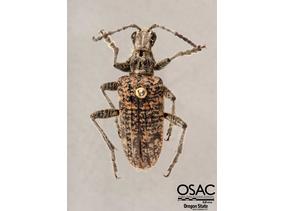You are here
Lepturinae
Rhagium inquisitor subsp. inquisitor (Linnaeus, 1758)
Nomenclature
SUMMARY
Rhagium, with its dense short hairs, mottled coloration, and distinctly pronounced elytral costae, is one of the most impressive and recognizable lepturine genera. While twenty-three species are currently recognized in 3 subgenera worldwide, North America is home to just one of these, the holarctic Rhagium inquisitor inquisitor.
Recently there has been a fair amount of physiological research using various species of Rhagium. Adults in this genus often overwinter under bark in extremely cold climates, raising the question of how they are able to keep from freezing. Kristiansen et al. (1999; 2012) investigated the proteins which apparently provide the haemolymph in Rhagium with remarkable antifreeze properties. Rhagium larvae have also been of interest to research into digestive enzymes (see Zverlov et al. (2003) and Chipoulet and Chararas (1984)).

Taxonomy
Rhagium inquisitor (Linneaus, 1758), the type species for the genus Rhagium, is one of the earliest cerambycids to be described by European naturalists. Although Carolus Linnaeus is credited with naming R. inquisitor (it appeared in his 1758 Systemae Naturae as Cerambyx inquisitor), the species had actually already been discussed and illustrated by the German entomologist Johann Leonhard Frisch, in his 1730 Beschreibung von allerley Insecten in Teutsch-Land (Tom. 13, tab.14). Frisch's book has been digitized and made available by openlibrary.org,
The genus was reviewed by Casey (1913) and Cenek Podany (1964), both of whom recognized several distinct species within our current concept of inquisitor. Linsley and Chemsak (1972, p. 88) provide a justification for placing Casey's and Podany's several names into synonymy, and considering our species the same as the European form. The synonyms of Rhagium are as follows (in italics):
Rhagium Fabricius, 1775:182
Stenocorus Geoffroy, 1762:221
Stencorus; Lamarck, 1817:312
Hargium Samouelle, 1819:210
Harpium; Reitter, 1912:6
Allorhagium Kolbe, 1884:270
inquisitor inquisitor (Linnaeus, 1758:393)
lineatus Olivier, 1795:13
investigator Mannerheim, 1852:283
californicum Casey, 1913:195
crassipes Casey, 1913:195
parvicorne Casey, 1913:195
boreale Casey, 1913:195
cariniventre Casey, 1913:196
thoracicum Casey, 1913:196
montanum Casey, 1913:197
mexicanum Casey, 1913:197
canadense Podany, 1964:30
americanum Podany, 1964:32
quadricostatum Podany, 1964:34
nigra Podany, 1978:4
Works Cited
- Casey, T. L. 1913. Further studies amongst the American Longicornia. Memoirs on the Coleoptera, 4:193-388. <Link to Biodiversity Heritage Library> <PDF>
- Chipoulet, Jm; Chararas, C., 1984: Purification and partial characterization of a laminarinase from the larvae of Rhagium inquisitor. Comparative biochemistry and physiology B: Comparative biochemistry7(4): 699-706
- Fabricius, J. C. 1775. Systema entomologiae, sistens insectorum classes, ordines, genera, species, adiectis synonymis, locis, descriptionibus, observationibus. Flensburgi et Lipsiae, 832 pp.
- Frisch, J. L. 1730. Beschreibung von allerley Insecten in Teutsch-Land. <openlibrary.org>
- Geoffroy, E. L. 1762. Histoire abrégée des insectes qui se trouvent aux environs de dans laquelle ces animaux sont rangés suivant un ordre méthodique. Durand. 1: xxviii + 523 pp., pls I-X.
- Hakim, A., Thakral, D., Zhu, D. F., and Nguyen, J. B. (2012) Expression, purification, crystallization and preliminary crystallographic studies of Rhagium inquisitor antifreeze protein. Acta Crystallogr. Sect. F Struct. Biol. Cryst. Commun. 68, 547–550
- Kristiansen E., Ramløv, H., Højrup P., Pedersen S. A., Hagen L., and K. E. Zachariassen. 2011. Structural characteristics of a novel antifreeze protein from the longhorn beetle Rhagium inquisitor. Insect Biochem Mol Biol. 2011 Feb;41(2):109-17. doi: 10.1016/j.ibmb.2010.11.002. Epub 2010 Nov 13.
- Kristiansen E., Pedersen S. A., Ramløv, and K. E. Zachariassen. 1999. Antifreeze activity in the cerambycid beetle Rhagium inquisitor. J Comp Physiol B (1999) 169: 55-60.
- Kristiansen, E., Wilkens, C., Vincents, B., Friis, D., Lorentzen, A. B., Jens- sen, H., Løbner-Olesen, A., and Ramløv, H. (2012) Hyperactive antifreeze proteins from longhorn beetles: Some structural insights. J. Insect Physiol. 58, 1502–1510
- Lamarck, Jean-Baptiste. 1817. Histoire naturelle des animaux sans vertèbres...l'exposition des principes fondamentaux de la Par M. de Lamarck. Tome 4. March, 1817. pp. 1-603. <Link to Biodiversity Heritage Library> <PDF>
- Linnaeus, C. (Carl von Linné). 1758. Systema Naturae per regna tria naturae secundum classes, ordines, genera, species. cum characteribus, differentiis, synonymis, locis. (ed. 10). Holmiae. Laur. Salvius. 1: iii + 824 pp.
- Linsley, E. G., and J. A. Chemsak. 1972. Cerambycidae of North America. Part VI. No. 1. Taxonomy and Classification of the Subfamily Lepturinae. University of California Publications in Entomology 69, xiii+138 pp, 2 pl.
-
Mannerheim, C. G. von. 1852. Zweiter Nachtrag zur Käfer-Fauna der Nord-Amerikanischen Länder des Russischen Reiches. Bull. Soc. Imp. Natur. Moscou,
25(2):283-387. - Olivier, A. G. 1795. Entomologie, ou Histoire Naturelle des Insectes, avec leurs Caractères Génériques et Spécifiques, leur Description, leur Synonymie et leur Figure Illuminée. Coléoptères. 4:1-519, 72 pls.
- Podany, C. 1964. Monographie des genus Rhagium Fabricius (Stenocorini). Acta zool. Mex., 7(1 3):1-55, 7 pls.
- Reitter, E. 1913. Fauna Germanica. Die Käfer des Deutschen Reiches. Nach der analytischen Methode bearbeitet. IV. Band. K. G. Lutz, Stuttgart, 236 pp. + pls. 129–152. [1912 (title page); 1913 (Zool. Record; Arch. Naturg. 80B); Feb 1914 (Ent. Litteraturbl.); 1 Mar 1914 (Ent. Bericht. 4 (76): 62)]
- Zverlov, V. V., Höll, W., W.H. Schwarz. 2003. Enzymes for digestion of cellulose and other polysaccharides in the gut of longhorn beetle larvae, Rhagium inquisitor L. (Col.,Cerambycidae). International Biodeterioration & Biodegradation 51: 175–179

